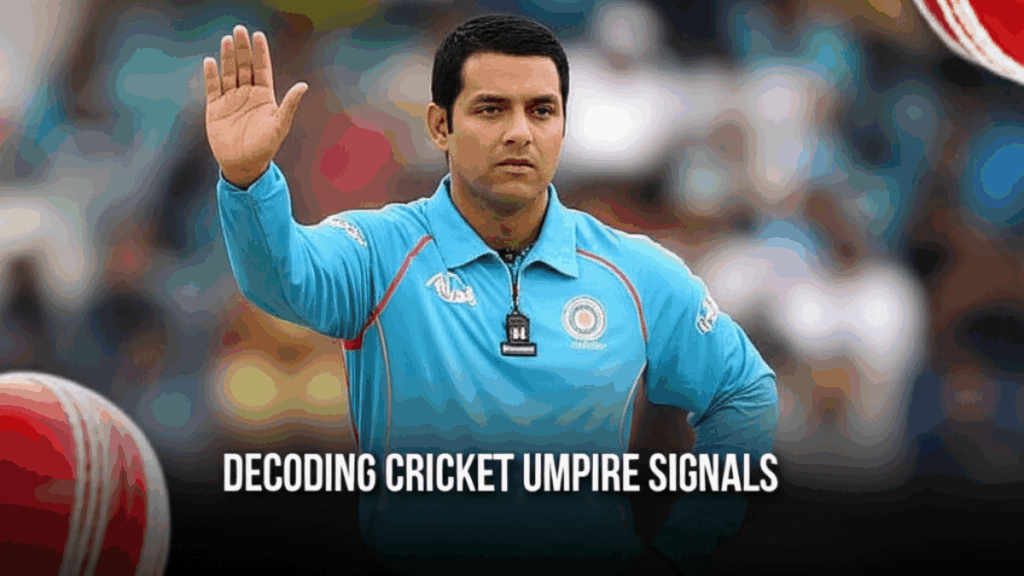
Cricket is not just a sport; it’s a symphony of strategy, skill, and, at times, controversy. As fans, we often find ourselves on the edge of our seats, cheering for our teams and analyzing every play. But have you ever wondered what those hand signals from the umpire really mean? Understanding cricket umpire signals is crucial for both players and spectators alike. Whether you’re a budding cricket player, a devoted fan, or someone new to the game, this comprehensive guide will decode those often-confusing gestures and enhance your cricket-watching experience.
In this article, we will explore the meanings behind cricket umpire signals, the reasons for their use, and how they contribute to the flow of the game. We’ll also provide practical examples and real-world applications, helping you understand when and why these signals are employed. By the end of this guide, you’ll not only be able to recognize each signal but also appreciate the art of umpiring and communication in cricket.
So, let’s dive into the fascinating world of cricket umpire signals and unravel their meanings!
Understanding Cricket Umpire Signals
At its core, cricket is a game governed by rules, and the umpires are its custodians. Their role is not only to enforce the laws of the game but also to communicate decisions clearly and effectively. Umpire signals serve as a visual language, conveying critical information to players, coaches, and spectators.
Why are these signals so essential? For one, cricket matches can be played in diverse conditions and settings, making it vital for everyone involved to understand the umpire’s decisions without ambiguity. Additionally, with large crowds and sometimes rowdy atmospheres, verbal communication may not always be effective. Signals ensure that the message gets through loud and clear.
The Basics of Umpire Signals
Before we delve into specific signals, it’s important to understand the basic principles behind them:
- Clarity: Signals are designed to be easily understood from a distance, allowing players and spectators to interpret decisions quickly.
- Consistency: Umpires use standardized signals across all formats of the game to avoid confusion.
- Authority: The umpire’s signals reinforce their position and decisions, ensuring respect and adherence from players and teams.
Key Components of Umpire Signals
Now that we’ve established the importance of umpire signals, let’s break down the most common signals used in cricket and their meanings. Each signal is a crucial part of the game, and knowing them can significantly enhance your understanding of what’s happening on the field.
Out
When an umpire raises their index finger above their head, it signifies that a batsman is out. This gesture is one of the most celebrated in cricket, often met with cheers from the fielding side and groans from the batting team.
Not Out
If the umpire shakes their head and does not raise their finger, it indicates that the batsman is not out. This signal is often followed by relief from the batting side and disappointment from the fielders.
Four Runs
When the ball crosses the boundary after bouncing, the umpire will wave one arm back and forth horizontally. This signifies that the batting team has scored four runs. It’s a moment of excitement, as it boosts the team’s score and energizes the crowd.
Six Runs
Raising both arms above the head signifies that the batting team has scored six runs. This usually occurs when the ball is hit over the boundary without touching the ground. Fans often erupt in cheers during this signal, as sixes are thrilling to watch.
Wide Ball
When the umpire extends both arms horizontally, it indicates a wide ball. This means the delivery was too far from the batsman to hit and results in an extra run for the batting team. Wides can frustrate bowlers, and understanding this signal helps spectators grasp the match dynamics.
No Ball
Raising one arm horizontally at shoulder height indicates a no ball. This can occur for various reasons, such as overstepping the crease or illegal deliveries. A no ball grants an extra run to the batting team and allows them to face an additional delivery.
Dead Ball
An umpire will cross and uncross their arms in front of their body to signify a dead ball. This means that the ball is no longer in play, often due to an interruption or an unfair play. Understanding this signal can help you follow the flow of the game better.
Change of Bowler
When the umpire raises one arm and points towards the bowler, it’s a signal for a change of bowler. This typically occurs after a certain number of overs, as per the game’s regulations. It’s a strategic moment, as teams often switch bowlers based on conditions or match situations.
Injury or Interruption
When the umpire raises both arms and crosses them above their head, it signals for a pause due to injury or other interruptions. This is crucial for ensuring player safety and maintaining the integrity of the game. Spectators can expect a temporary halt in play when they see this signal.
Five-Run Penalty
In cases of unfair play or rule violations, the umpire may signal a five-run penalty to the batting or fielding team. The umpire will place one hand on the opposite shoulder while raising the other arm. This signal highlights the importance of sportsmanship and adherence to the laws of cricket.
Benefits and Importance of Umpire Signals
Understanding umpire signals enhances the overall experience of watching cricket. Here are some key benefits:
- Enhanced Engagement: Knowing what each signal means keeps you engaged throughout the match, making every moment more exciting.
- Better Understanding of the Game: Recognizing signals helps you follow the game’s flow and understand the decisions made by umpires.
- Informed Discussions: Your conversations with friends and fellow fans become more meaningful when you can discuss the nuances of decisions and strategies.
Moreover, for aspiring players, understanding these signals is essential for effective communication on the field. It fosters teamwork and helps players respond appropriately during matches.
Practical Applications
Now that we’ve explored the various umpire signals and their meanings, let’s look at how you can apply this knowledge in real-life scenarios.
During Matches
Next time you watch a cricket match, pay close attention to the umpire’s signals. Try to predict the umpire’s call based on the play unfolding in front of you. This practice not only sharpens your understanding but also enhances your enjoyment of the game.
Coaching and Training
If you’re involved in coaching or training young cricketers, take the time to teach them the meanings of these signals. This knowledge will not only help them on the field but also instill a greater appreciation for the game.
In Discussions and Analysis
When discussing matches with peers or on social media platforms, referencing specific umpire signals can add depth to your analysis. You can discuss how a no ball or wide affected game momentum, leading to valuable insights.
Frequently Asked Questions
What is the purpose of umpire signals in cricket?
The primary purpose of umpire signals is to communicate decisions clearly to players, coaches, and spectators. Given that cricket is played in various conditions, visual signals ensure that everyone understands the umpire’s ruling without confusion. This clarity is essential for maintaining the flow of the game and ensuring that all participants are on the same page.
Are there different signals for different formats of cricket?
No, the umpire signals used in cricket are standardized across all formats, including Test matches, One Day Internationals (ODIs), and Twenty20 (T20) games. This consistency helps players and fans recognize and understand signals regardless of the match format, which is vital in a globally followed sport like cricket.
How can I learn more about umpiring?
If you’re interested in learning more about umpiring, consider enrolling in an umpiring course offered by cricket governing bodies or local clubs. These courses cover the rules of the game, signal meanings, and practical on-field training. Additionally, watching matches and observing umpires in action can provide valuable insights into their decision-making processes.
What happens if an umpire makes a mistake with a signal?
While umpires strive for accuracy, mistakes can happen. If an umpire makes an incorrect signal, the game may pause while they clarify their decision, often with input from the third umpire or match referees. Players, coaches, and spectators usually respect the umpire’s authority, but discussions about decisions are common in post-match analyses.
Can spectators influence umpire signals?
While spectators can express their opinions and reactions vocally, they cannot influence umpire signals. Umpires are trained to make decisions based on their observations and the laws of the game, remaining impartial to crowd reactions. This independence is crucial for maintaining fairness and integrity in cricket.
How do umpires communicate with each other during a match?
Umpires use a combination of verbal communication, signals, and sometimes walkie-talkies to coordinate during a match. They are trained to work together as a team, ensuring consistency in decision-making and maintaining the game’s flow. This coordination is vital, especially in high-stakes matches where split-second decisions can impact the outcome.
What is the role of technology in umpiring?
Technology has become an integral part of modern cricket umpiring. Tools like the Decision Review System (DRS), which includes ball-tracking and ultra-edge technology, assist umpires in making accurate decisions. However, umpires still have the final say, ensuring that human judgment remains a key aspect of the game.
Conclusion
Understanding cricket umpire signals is not just about knowing what each gesture means; it’s about enhancing your appreciation for the game. Whether you’re a player, a passionate fan, or someone just getting into cricket, recognizing these signals can transform your viewing experience. It adds layers to your understanding and allows you to engage more meaningfully with the game.
As you watch your next cricket match, take a moment to observe the umpire’s signals. Each gesture tells a story—one that reflects the rules, the strategy, and the spirit of the game. So, dive deeper into the world of cricket and enjoy every moment, from the thrill of a six to the tension of an umpire’s decision. And remember, the next time you see an umpire raise a finger, you’ll know exactly what it means!




